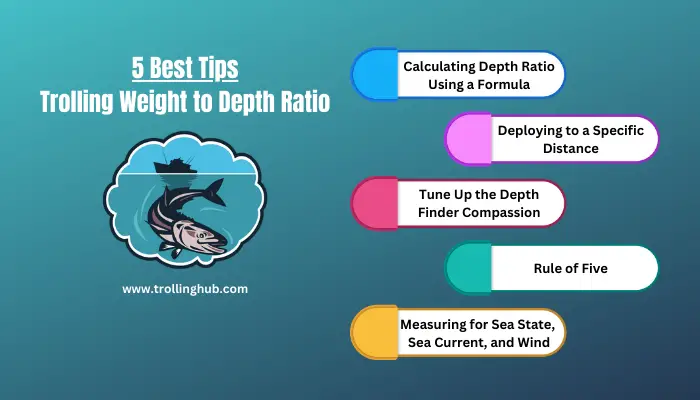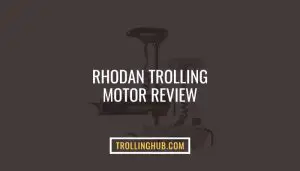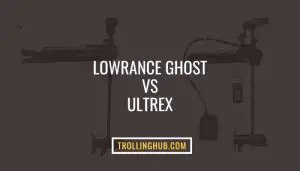There is a specific measurement for trolling weight and depth ratio; for instance, you should go for 4oz trolling weight with 40′ depth. The reel will get several cranks, and you’ll be stuck if the trolling weight exceeds that depth ratio. So, it’s important to go through an accurate trolling weight to depth ratio.
Many people overlook the thrill of fishing due to their confusion about the ultimate trolling weight to depth ratio. You can determine the trolling weight to exact depth ratio easily. And, we’re here to help get these ways.
There are a number of factors to consider when you want to identify the trolling weight. You must consider the speed, weight of the line, weight of the lure, current, etc. to get the exact depth ratio of your trolling weight. Stay with us to know all these matters!
How to Determine Trolling Weight to Depth Ratio
Here are 5 best tips to determine your actual trolling weight for its depth. Besides, there are several apps for getting trolling weight depth. So, we will share all these ways to make your fishing job easier.

Going through these 5 ways, you can accurately explore the real depth ratio.
- Calculating Depth Ratio Using a Formula.
- Deploying to a Specific Distance.
- Tune Up the Depth Finder Compassion.
- Rule of Five
- Measuring for Sea State, Sea Current, and Wind Conditions.
Calculating Depth Ratio Using a Formula
Identify the angle between the horizon and the line and follow the given formula-
Depth= Line Distance × SINE.
And, then subtract the accurate distance from the total rod tip to the waterline. You can easily find out the right depth ratio following this way.
Measuring Depth by Deploy to a Specific Distance
It is another wonderful way to get the depth ratio of trolling weight. First, deploy it to a certain distance and troll up the edge until it begins to drag the bottom. Then, all you need to do is to note the depth now. But, you’ve to apply this method carefully or else it will lose the rig. At this point, this method can be a bit risky for the first-time tester.
Tune Up the Depth Finder Compassion
If you tune up the depth finder’s sensitivity, it will get you a clear result on thermocline. However, make sure you tune up until you see the thermocline. Next, take a thermometer and clip this onto the rig.
Afterward, keep trolling for 5 to 7 minutes and pull the line as fast as you can after that 5 minutes of trolling. Finally, check out the thermometer, it will show the actual depth ratio.
Rule of Five
Determining the depth ratio based on the rule of five is the easiest way. The rule of five means – first, troll your boat at 5 MPH with 5 ounces of weight and 50 pound test line. Additionally, set it 50 ft behind your boat. At that time, the lure will run approximately 5 Ft under the surface.
Determining Depth by Measuring for Sea State, Sea Current, and Wind Conditions
This is also another method that you can apply hassle-free. First, set all your fishing lines and negate the effects of the outside issues through current, sea state, and wind conditions.
Additionally, these three factors can help you get the actual depth ratio for your trolling weight. When the trolling crosses the state, current, and wind, it will influence the lure depth and show the depth.
More Ways to Know How Deep Your Gear Is In
If you find the 5 above methods challenging to follow, we’ve ways for you. Go through the following two amazing ways and explore more.
Use a Downrigger
Using a downrigger is one of the most wonderful ways to get you the exact depth ratio. First, get a cosine of the angle of the downrigger and multiply it by the counter depth of the downrigger. Consequently, the number you see will be the fishing depth ratio. Here’s an example-
Suppose, you get a fish in a 150Ft depth and place the downrigger at that exact depth measurement of 150Ft depth. Now calculate this way- (150 Ft × Cos 45=106Ft) is the total depth.
Depth Measurement Table
Another easiest way to find the depth is to go through our measurement table. Look at the given measurement depth
Trolling Weight Depth Ratio Chart
| Line Out (In Feet) |
Depth (in Feet) | ||||||
|---|---|---|---|---|---|---|---|
| 6OZ | 5OZ | 4OZ | 3OZ | 2OZ | 1OZ | ||
| 100 | 60 | 56 | 49 | 43 | 25 | 17 | |
| 90 | 55 | 50 | 43 | 39 | 24 | 16 | |
| 80 | 50 | 44 | 39 | 35 | 23 | 15 | |
| 70 | 45 | 39 | 35 | 32 | 21 | 14 | |
| 60 | 40 | 36 | 31 | 28 | 19 | 13 | |
| 50 | 35 | 31 | 27 | 24 | 17 | 12 | |
| 40 | 30 | 27 | 23 | 20 | 15 | 11 | |
| 30 | 23 | 21 | 19 | 16 | 13 | 10 | |
| 20 | 16 | 15 | 14 | 12 | 10 | 7 | |
In the above trolling weight depth ratio table provides a convenient reference for determining depth based on the length of the line released and the weight of the trolling lure. It offers depth measurements in feet for various combinations of line out and lure weight. This guide can assist anglers in estimating the depth at which their trolling setup operates, facilitating more effective and precise fishing strategies.
Trolling Depth Calculator App
Here again, we’ve got you an outstanding way to find out the trolling weight depth ratio, and that’s Troll Master App. This app will help you take all your guesswork about trolling depth and weight out.
You can select the line, trolling weights, lure, and driver, and combine them to find the depth ratio using this depth calculator depth app. It is fast and easy to use for you. You can even observe if the trolling weight, rod height, leader length, lures, and all other factors change. Pretty Amazing!
How to apply trolling weight and depth ratios to target specific fish species effectively?
To apply trolling weight and depth ratios successfully when targeting specific fish species, you’ll want to delve deeper into specialized guides tailored to each species.
How to apply trolling weight and depth ratios to trolling for pike?
To effectively troll for pike, select the appropriate depth, typically ranging from 5 to 15 feet, depending on conditions. Use the right trolling weight, ensuring it’s heavy enough to reach your desired depth without getting snagged. Maintain a trolling speed between 2 to 4 miles per hour, which is generally attractive to pike.
Experiment with these factors until you find the combination that entices pike to bite, as pike behavior can vary. Adjust your setup as needed to maximize your chances of a successful catch. If you’re interested in exploring more techniques for trolling pike, be sure to check out our article “Trolling For Pike: 5 Must-Try Techniques for Trolling Pike” It provides valuable insights into additional strategies that can help you improve your pike trolling skills.
How to apply trolling weight and depth ratios to trolling for kingfish?
To successfully troll for kingfish, start by determining the ideal depth, often ranging between 20 to 60 feet, based on local conditions and advice from experienced anglers. Employ downriggers or appropriate weights to control your bait or lure’s depth.
Maintain a trolling speed of around 4 to 6 miles per hour, which tends to attract kingfish. Be ready to adjust your trolling depth, weight, and speed as kingfish behavior can vary. For more comprehensive tips and expert advice on trolling for kingfish, you can also explore our article “Trolling For Kingfish: 7 Best Expert’s Tips.” These additional strategies can provide valuable insights to enhance your kingfish trolling skills.
Final Thoughts
Trolling weight is a wonderful sinker to take the bait rigs in the deepest zone. Trolling weight lets the bait stay in the right position and increases stability. But, you must identify the trolling weight to depth ratio position perfectly.
Many more ways are there to follow, but not all of them are necessary to go through. You can easily determine the trolling weight depth ratio with the help of the mentioned methods above. Thanks for Being with Us!



